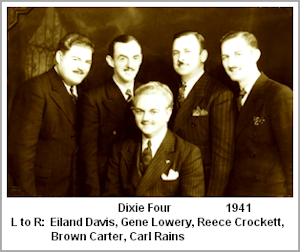 |
Group MembersTenor |
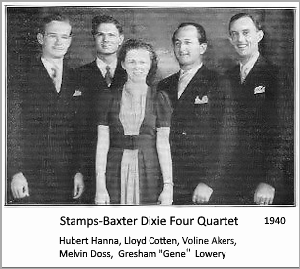 |
 |
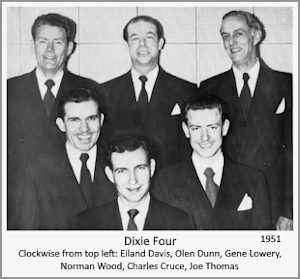 |
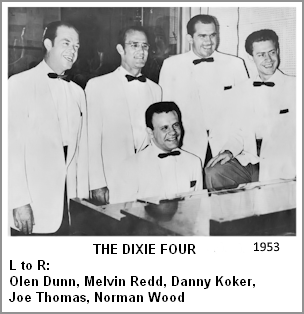 |
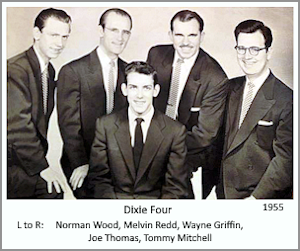 |
The Dixie Four (1938-1942; 1944-1955) ("Dixie Four" was used by other musical groups during the 1920s and 1930s. This article covers the history of the two groups launched by Gene Lowery in 1938 and 1944.)
History
The forerunner to the Dixie Four Quartet was organized in Jackson, Mississippi in 1938 by Gene Lowery, who was a radio personality and a church music director. The early group was called the Stamps Gospel Four and was composed of Lowery, Hubert Hanna, A.D. Huffman, Lloyd Cotten, with Miss Marion Robinette, pianist.
The quartet moved to Memphis in March, 1940 to sing on radio station WMC. They were affiliated with the Stamps-Baxter Music Company and were called the Stamps Dixie Four. The members pictured in the Stamps-Baxter Album in 1940 included Gene Lowery, Hubert Hanna, Lloyd Cotten, Melvin Doss, and Voline Akers.
By early 1941 the members in Memphis were Eiland Davis (tenor), Gene Lowery (lead), Brown Carter (baritone), Carl Rains (bass), and Reece Crockett (pianist).
In the Spring of 1941 Gene Lowery and the others of the Dixie Four parted company. The remaining group became known as the Stamps-Baxter Dixie Quartet. Bass singer Carl Rains was their leader. They left Memphis and joined WDZ radio in Tuscola, Illinois. Then they moved on to Beaumont, Texas and later to Jackson, Tennessee before wartime rationing limited their ability to travel. Unable to make a living, the group disbanded in 1942.
A few years later, the Stamps-Baxter Dixie Quartet name would resurface. Click HERE to read more about that group.
Shortly after his quartet members had moved on, Gene Lowery re-started his Dixie Four, affiliated with the Vaughan Music Publishing Company. Group members were Melvin Doss, Gene Lowery, Irby Palmer, Chalmers Walker, and Voline Akers. After a few months, Irby Palmer left and Byron Faust joined the group. The Vaughan Dixie Four continued operating for most of the remainder of 1941 and well into 1942. They disbanded for about a year and a half due to wartime military service by Lowery and others in the group.
Reorganized Dixie Four
Gene Lowery, who had retained the Dixie Four name, reorganized a new Dixie Four in 1944. In addition to Lowery, the group included former members Byron Faust (tenor), Melvin Doss (baritone), Voline Akers (pianist), and new member, Morris Jones (bass). The group returned to WMC radio in Memphis. Their programs were also carried on KWKH in Shreveport.
In 1946 they moved to Indianapolis, Indiana where they performed regularly on WIBC radio. By 1947, they were heard on the Mutual Broadcasting System which carried its programming from coast to coast through hundreds of affiliate stations. The members around that time were Melvin Doss (tenor), Gene Lowery (lead and emcee), Loyal Shorty Green (baritone), Olen Honey Dunn ( bass), and Herschel Collins (pianist). Dunn was a former bass singer for the Lone Star Quartet. Melvin Doss left in late 1947 and was replaced at tenor by former tenor Eiland Davis. This lineup lasted for around two years.
Gene Lowery, who also had various business interests, transitioned away from his regular singing role after Joe Thomas joined the group in 1949. Herschel Collins left the Dixie Four and became an evangelist and a pastor. Before long, Davis and Green were gone. Norman Wood, formerly of the All American Quartet, joined Dixie Four. After some additional turnover, Reece Crockett came back at piano. Although there were a number of personnel changes during the early 1950s, Thomas, Wood, and Dunn remained.
In 1952 Gene Lowery sold his businesses in Indianapolis and moved to Olney, Illinois, where he became affilated with the Southland Quartet.
A later lineup of the Dixie Four included Joe Thomas (tenor), Norman Wood (lead), Melvin Redd (also formerly of the All American Quartet, baritone), Olen Dunn (bass), and Danny Koker at piano. They appeared regularly on television in the region. Koker moved on to the Weatherford Quartet in late 1954. He was replaced by Wayne Griffin, another former member of the All American Quartet.
By January 1, 1955, the Dixie Four had relocated to Shenandoah, Iowa and had joined KMA radio. The members were Joe Thomas (tenor), Norman Wood (lead), Melvin Redd (baritone), Tommy Mitchell (bass), and Wayne Griffin (pianist). The Dixie Four continued to operate until they disbanded around the middle of 1955.
The Dixie Four recorded on the TruTone label, on Gene Lowery's own "Gospel Records" label, and later on a Dixie Four private label. Recitations were an integral part of their radio and television broadcasts and were included in the several songbook editions they published. The Dixie Four tended to sing the songs as written with less variation from the original compositions than some other quartets of the period. They did, however, include some of the more jazzy numbers that were being sung by quartets farther south. Following Lowery's departure, with Reece Rocket Crockett at the piano, more entertaining arrangements were added. Another feature, while not unique to the Dixie Four, was their inclusion of an organist in addition to the traditional pianist as a regular member of the group. As was the case for several Dixie Four lineups through the years, the Dixie Six might have been more accurate. Bill Gaither has said that Gene Lowery and The Dixie Four Quartet was an important model for him as he entered and progressed in the gospel music profession.
Discography (incomplete)
1947 (TruTone Records DF-1): If We Never Meet Again This Side Of Heaven; Just Beyond The Surging Tide (also released as TruTone 1001)(Melvin Doss, Gene Lowery, Loyal Green, Olen Dunn, Herschel Collins).
1947 (TruTone Records DF-2): Just A Little Talk With Jesus; He’ll Understand And Say Well Done (also released as TruTone 1002)(Melvin Doss, Gene Lowery, Loyal Green, Olen Dunn, Herschel Collins).
1947 (TruTone Records DF-3): On The Jericho Road; Take The World And Give Me Jesus (also released as TruTone 1003)(Melvin Doss, Gene Lowery, Loyal Green, Olen Dunn, Herschel Collins).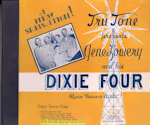 hi-res
hi-res
1947 Gene Lowery And His Dixie Four (TruTone Records DF-100): (Three 78 RPM records—TruTone 1001, 1002, and 1003 packaged as an album)(Melvin Doss, Gene Lowery, Loyal Green, Olen Dunn, Herschel Collins shown on album cover).
1947 (TruTone Records 1015): I Won’t Have To Cross Jordan Alone; There Is A Fountain (Melvin Doss, Gene Lowery, Loyal Green, Olen Dunn, Herschel Collins, Hassell Kimbrough).
1947 (TruTone Records 1016): Keep On The Firing Line; The Great Redeemer (Melvin Doss, Gene Lowery, Loyal Green, Olen Dunn, Herschel Collins, Hassell Kimbrough).
1947 (TruTone Records 1017): Amazing Grace; I Will Meet You In The Morning (Melvin Doss, Gene Lowery, Loyal Green, Olen Dunn, Herschel Collins, Hassell Kimbrough).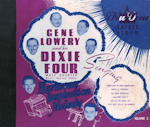 hi-res
hi-res
1947 Gene Lowery And His Dixie Four Volume 2 (TruTone Records DF-200): (Three 78 RPM records –TruTone 1015, 1016, and 1017 packaged as Volume 2 album)(Melvin Doss, Gene Lowery, Loyal Green, Olen Dunn, Herschel Collins, Hassell Kimbrough shown on album cover).
1948 (TruTone Records 1031): We Are Climbing; Must Jesus Bear The Cross Alone (Eiland Davis, Gene Lowery, Loyal Green, Olen Dunn).
1948 (TruTone Records 1032): Jesus Paid It All; In The Sweet Forever (Eiland Davis, Gene Lowery, Loyal Green, Olen Dunn).
1948 (TruTone Records 1033): Swing Low; Sweet Bye And Bye (Eiland Davis, Gene Lowery, Loyal Green, Olen Dunn).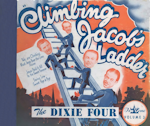 hi-res
hi-res
1948 Climbing Jacob's Ladder (TruTone Records DF-300): (Three 78 RPM records, TruTone 1031, 1032, and 1033 packaged as Volume 3 album)(Eiland Davis, Gene Lowery, Loyal Green, Olen Dunn shown on album cover).
1949 (TruTone Records 1052): What A Happy Time; Sweet By And By.
1949 (TruTone Records 1053): I Got That Old Time Religion In My Heart; Softly And Tenderly.
1949 (TruTone Records 1054): Rock Of Ages Hide Thou Me; Church In The Wildwood.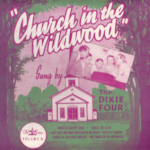 hi-res
hi-res
1949 Church In The Wildwood (TruTone Records DF-400): (Trutone 1052, 1053, and 1054 packaged as Volume 4 album)(Eiland Davis, Gene Lowery, Loyal Green, Olen Dunn, Herschel Collins shown on album cover).
19?? (TruTone Records): Cool Water; My Pretty Girl.
19?? (Gospel Records 501): A Beautiful Life; Dry Bones.
19?? (Gospel Records 502): I’ve Found A Hiding Place; Hand And Hand With Jesus.
19?? (Gospel Records 503): Hide Me Rock Of Ages; Just A Closer Walk With Thee.
19?? (Gospel Records 504): I’d Rather Have Jesus; Take My Hand, Precious Lord.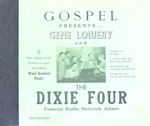 hi-res
hi-res
19?? Gene Lowery And The Dixie Four (Gospel Records ???): (Four 78 RPM records –Gospel 501, 502, 503, and 504 packaged as an album)(Eiland Davis, Joe Thomas, Loyal Green, Olen Dunn, Gene Lowery, and Herschel Collins shown on album cover).
1950 (Gospel Records 505): Riding The Range For Jesus; The Haven Of Rest.
1950 (Gospel Records 506): Precious Memories; Life’s Railway To Heaven.
1950 (Gospel Records 507): In The Garden; I’ll Be Looking For You.
1950 (Gospel Records 508): When They Ring The Golden Bells; Beautiful Isle Of Somewhere.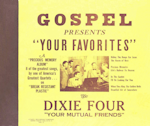 hi-res
hi-res
1950 Your Favorites (Gospel Records ???): (Four 78 RPM records –Gospel 505, 506, 507, and 508 packaged as album Volume 2)(Eiland Davis, Joe Thomas, Loyal Green, Olen Dunn, Gene Lowery, and Herschel Collins shown on album cover).
195? (Gospel Records 509): Jesus Hits Like The Atom Bomb; Holy Ghost With Light Devine.
195? (Gospel Records 510): On The Jericho Road; I’m Free Again.
195? (Gospel Records 511): He’ll Understand And Say Well Done; We’ll Stand By The Red, White, And Blue.
195? (Gospel Records 512): If We Never Meet Again; I Won’t Have To Cross Jordan Alone.
195? (Gospel Records 513): Beyond The Sunset; Zion’s Hill.
195? (Gospel Records 514): Where Is My Wandering Boy Tonight; Mother's Prayers Have Followed Me.
195? (Gospel Records 515): When He Reached Down His Hand For Me; The Old Account Was Settled Long Ago.
195? (Gospel Records 516): It Is No Secret; Checking Up On My Payments.
195? (Gospel Records 517): The Love Of God; We Are Going Down The Valley.
195? (Gospel Records 518): Lead Me To That Rock; The King’s Highway.
195? (Gospel Records 519): Kneel At The Cross; Lead Me To That Rock.
195? (Gospel Records 520): The Beautiful Garden Of Prayer; Peace In The Valley.
195? (Gospel Records 521): Leaning On The Everlasting Arms; I Want To Rest.
195? (Dixie Four Records 101): My Journey To The Sky; If You Never Learned To Pray.
195? (Dixie Four Records 102): Mansion Over The Hilltop; Roll On Jordan.
195? (Dixie Four Records 103): Wait Till You See Me In My New Home; I’ve Got That Old Time Religion In My Heart.
195? (Dixie Four Records 105): Blessed Is He That Readeth; No One Ever Cared For Me Like Jesus.
195? (Dixie Four Records 106): He Bought My Soul At Calvary; Satisfied.
195? (Dixie Four Records 107): Noah; Just Take It To Jesus.
1953 (Dixie Four Records 109): His Hand In Mine; My Desire.
195? (Dixie Four Records 110): Do Lord; The Man Upstairs.
(Most of the Gospel Records recordings were issued in both 78 and 45 RPM).
